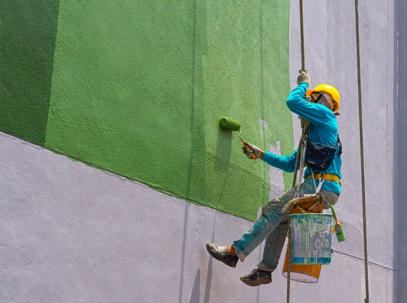When Is It Too Cold to Paint Outside? Cold Weather Paint Temperatures
Professional painters consider outdoor temperatures for every successful paint job. We prefer to paint when the air temperature reaches above 50°F, and we avoid drops below 32°F. Even warm daytime temperatures will not ensure a durable finish if the nights become too cold. You can save yourself a lot of time and money by understanding how temperature affects paint.
How Does the Temperature Affect the Quality of a Paint Finish
For better or worse, temperature can affect the quality of a paint finish. Painting at the right surface temperature prevents improper curing and minimizes issues like cracking, peeling, and chipping.
Avoid painting at low surface temperatures because may cause some exterior paints to thicken, resulting in uneven coats, running paint lines, and sagging.
Even if a stain is at the right temperature, applying it to a freezing surface might lead to adhesion problems. Waiting for the ideal painting temperature is essential for a smooth, long-lasting finish.
Recognizing the Impact of Hot Weather
Professional painters always try to paint at the optimal temperature. If the temperature is above 90°F, it might lead to quick-drying, compromised adhesion, bubble formation, peeling, and blisters.
Identifying the Effects of Cold Temperatures
Low temperatures negatively impact paint curing. When the temperature drops below 55°F, the drying process slows down. This prolonged wetness allows more insects, dirt, grime, and debris to get stuck in the paint.
Also, oil-based paints thicken in colder temperatures, leading to a stiffer brushing experience, heavier application, and reduced coverage per gallon.
Ideal Temperature for House Exterior Painting Projects
For exterior paint projects, the best temperature range varies based on the paint type. Latex paint is best applied between 50° and 70°F, while oil-based paint performs well between 45° and 90°F.
If painting in cooler temperatures, specially formulated latex paint can work effectively even at temperatures as low as 36°F. This paint contains coalescing agents to enhance its curing properties in low temperatures.
Essential Factors for Painting Outside
Painting pros factor in the surface and air temperatures before applying paint. Some exterior surfaces may need time to warm up after a long winter.
Exterior painting experts also recommend painting in the shade to avoid the paint drying too quickly in direct sunlight or on hot surfaces.
Allow ample time for the paint to dry before sunset to avoid cooler temperatures and dew formation.
Let’s examine some of the most crucial factors for painting outside.
Monitoring Weather Conditions for Effective Painting
Skilled painters review the weather forecast before their painting projects. Aside from temperature, drying times are influenced by factors like humidity, sunlight, and other environmental conditions.
During colder weather, direct sunlight can increase the surface temperature of building materials, expediting the drying process. Experts recommend waiting for a few days in a row with high temperatures and clear skies.
Understanding the Influence of Humidity on Paint Performance
Painting within the recommended humidity levels of 40% and 70% is crucial to avoid the challenges associated with excessive humidity during exterior painting projects.
Monitoring dampness prevents issues like leaching, compromised paint protection, and slow moisture evaporation, which will ensure shorter cure times and better finishes.
When painting wood surfaces, consider the excess moisture that wood absorbs from the air. In some cases, the moisture might hinder paint adhesion or cause bubbling and peeling.
Assessing the Usability of Previously Frozen Paint
Old, water-based paints that have experienced multiple freeze-thaw cycles might still have some life left. However, if the previously frozen paint contains lumps and does not achieve a smooth consistency when mixed, it is no longer usable.
Water-based paint freezes at 32°F, but oil-based paint can tolerate lower temperatures.
Choosing Paint for Different Environmental Factors
Improve results with specialized paint designed for lower curing temperatures. Even when using low-temperature paints, try to maintain the minimum recommended temperature throughout the curing process, not just the application.
In colder weather, choose brushes made with nylon, polyester, or Chinex bristles to avoid paint thickening. Unlike standard paint, low-temp paint offers exceptional performance at near-freezing temperatures.
Common Questions About Painting in Colder Weather
What happens if you paint outside when it’s too cold?
You may encounter several issues if you paint outside when it is too cold. The curing process takes longer in colder temperatures, which affects the paint’s durability by making it prone to cracking. Dew may also form on the surface, causing the water in the paint to evaporate more slowly, which leads to stains or mildew formation.
Will exterior paint dry in cold weather?
Exterior paint will dry in the cold weather, but it delays the drying time for oil and water-based formulations. For instance, at 75°F, painters can apply a second coat four hours after the first coat. But, colder weather of about 50°F may prolong the required time to six hours.
How long can paint last in cold weather?
Paint can last 1-2 years in cold weather. Its longevity depends on the type of paint and storage conditions. In winter, Homeowners should store paint in a warm, dry place to maximize the shelf life of their paints.
Protect Your Home Against Extreme Weather With Groovy Hues
Understanding the interplay between exterior paint and weather conditions allows you to extend your paint’s lifespan. Protect your property with the right paint applied by the best painting company. Call Groovy Hues at (844) 394-8660 to book a free consultation today!





